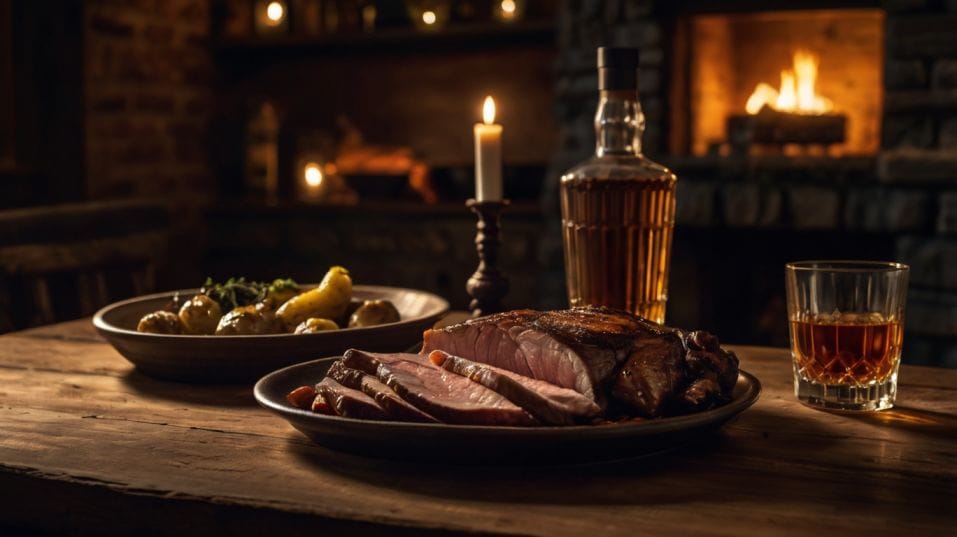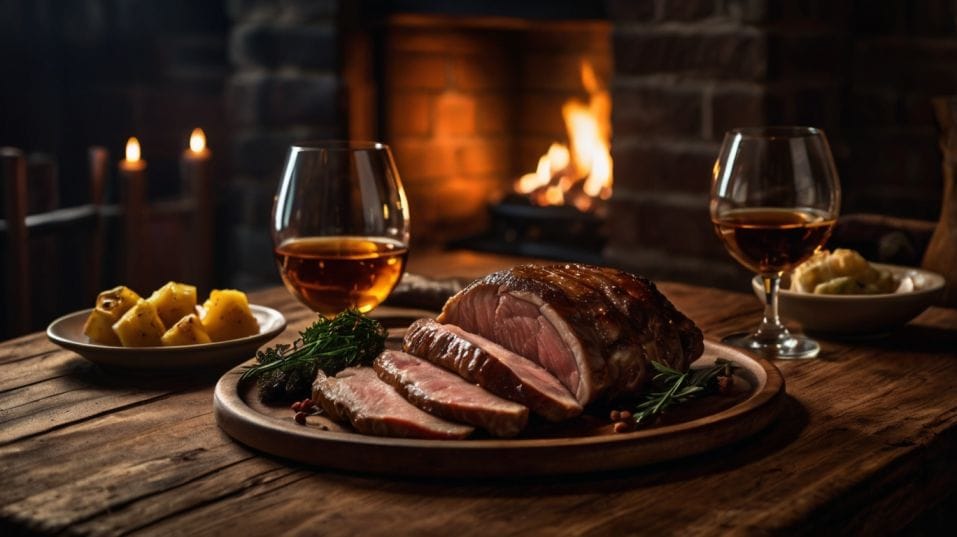Best Whiskey to Serve with Roast Dinner
Discover the best whiskeys to serve with roast dinner. Learn to pair with purpose and taste with confidence—even if you're new to whiskey.

What if your roast dinner could unlock your whiskey collection? Forget saving your best bottle for a quiet night—this is where flavor gets interesting.
Whiskey has the backbone to handle the richness of roast meats, the complexity to play with sides, and the precision to sharpen every bite.
If you’re early in your whiskey journey, this is the perfect way to taste with purpose. Let’s turn comfort food into a confident, flavor-first experience.
Why Whiskey Belongs on the Roast Table
Most people default to red wine when serving roast dinners. It’s familiar, it’s safe, and it “works.”
But whiskey, when approached with intent, does more than work—it enhances. The reason? It brings three things wine rarely does in the same combination: concentrated flavor, structural precision, and aromatic range.
A roast dinner is a heavyweight dish. Whether you’re serving beef, lamb, pork, or game, you’re dealing with browned proteins, rendered fat, roasted aromatics, and rich side dishes.
Whiskey, particularly well-aged or cask-strength varieties, has the guts to match that intensity. But it’s not just about brute force.
The right whiskey creates contrast where you need lift, echo where you want harmony, and grip where you need balance.
You’re not pairing for effect. You’re pairing for experience. That means choosing whiskeys that engage with your food, not bulldoze it.
To do that, you have to think about how flavor behaves in context—how a caramelized onion or herb-studded crust will interact with a dram’s sweetness, spice, or tannin.
These aren’t soft decisions. They’re what take you from casual drinking to controlled, confident tasting.

Understanding the Core Matching Principles
If you want to pair whiskey with roast dinners successfully, forget gimmicks. Focus on structure. Here’s how it breaks down:
Weight and Texture
Match the body of the whiskey to the richness of the dish. A light, delicate malt will disappear under a roast beef’s umami weight. A bold, oily whiskey will steamroll over roast chicken.
Medium-bodied whiskeys—those aged in sherry, red wine, or toasted oak—tend to strike the sweet spot. They bring weight, but they also have acid, spice, or fruit to keep things moving.
Cask Influence
Think of the cask as the whiskey’s seasoning. Sherry casks bring dried fruit, spice, and umami—perfect with beef or lamb. Bourbon casks lean vanilla, caramel, and toasted nut—excellent with pork or root vegetables.
Wine casks (like Madeira, port, or red wine) add acidity and tannin, creating brightness where a dish might feel heavy.
Grain Character
This is often overlooked, but grain matters. Single malts offer a malt-forward, rounded character. Grain whiskeys tend to be lighter, cleaner, and slightly sweet.
Blends offer both, but with variation. A higher rye content will deliver more spice and snap—a great foil for fattier dishes like pork shoulder or duck.
Finish and Length
Pay attention to how the whiskey finishes. A long, dry finish helps reset your palate after a rich bite. A short, sweet finish can lift a dish’s earthy or bitter edge. Balance comes from how the dram exits—not just how it starts.
Choosing the Right Whiskey for the Meat
Now let’s get practical. You’re standing in front of your whiskey shelf or shopping for a bottle. Here’s how to think based on the roast.
Beef Roast (Ribeye, Sirloin, Brisket)
You want depth, but not just smoke. A sherry-aged single malt, a bourbon with age and spice, or a balanced blend with some peat influence can hold up here.
You’re looking for richness to mirror the Maillard crust and just enough tannic grip to clean the fat.
Lamb (Leg, Shoulder, Rack)
Lamb’s gamey edge plays well with spice and fruit. Look for whiskeys with sherry, port, or red wine cask finishes.
A Highland malt with herbal lift or a rye-forward bourbon adds dimension. If there are mint or rosemary notes in your seasoning, match them with whiskeys showing dried herbs or light citrus peel.
Pork (Roast Loin, Belly, Shoulder)
Pork needs sweetness and acidity. Bourbon is a natural fit—especially those with a strong caramel core or orchard fruit profile.
But a Speyside single malt with a crisp apple or pear note can work beautifully, especially if you’re serving with apple sauce or spiced glaze.
Poultry (Chicken, Turkey, Game Birds)
Lighter meats call for brighter whiskeys. A soft grain whiskey with a clean finish, a young malt with floral or honeyed notes, or even a delicate blend with subtle spice will complement rather than compete.
If your poultry is smoked or roasted hard, step up to something with toasted oak or a slight peat note.
Vegetables, Sides, and Gravy
Don’t overlook the extras. Gravy carries fat and umami—match it with whiskeys that finish dry. Roasted root vegetables respond well to toasty sweetness.
Stuffing, especially with sage or dried fruit, pairs easily with malts aged in wine or fortified casks.
Tasting and Serving: Real-World Techniques
You don’t need a tasting mat and pipette. But you do need intentionality.
Pour Small
You’re not running a flight—you’re enhancing a meal. Two ounces, neat or with a splash of water, is plenty.
Use Proper Glassware
Tulip glasses or Glencairns focus the aroma. Rocks glasses can work, but they tend to mute subtler notes. Avoid big bowls that diffuse the nose too quickly.
Control Temperature
Room-temp whiskey can get flabby against a hot meal. A short chill (10 minutes in the fridge) tightens it up. Or try a single small ice cube if the proof runs high.
Taste in Rhythm
Try a bite, then a sip. Reverse it. Notice how the whiskey’s character shifts with food. That’s where pairing becomes discovery. Over time, you’ll start anticipating how a whiskey will behave before it hits the glass.
Offer Contrast and Context
Serving one whiskey is clean and intentional. Offering two can teach you something. Try a bourbon next to a sherry malt with roast pork and you’ll start to feel how grain, cask, and finish tell different stories.
Final Thoughts
If you want to collect smarter and taste better, start using your whiskey. Don’t save the good bottle for a “whiskey night.” Pour it with a meal. Roast dinners are the perfect platform—rich, layered, and open to experimentation.
Get past the idea that whiskey sits alone in a glass. Pair it with purpose. Learn what works. Build a memory around flavor—not hype.
Pick a roast. Choose a bottle that fits the mood. Pour with intent. And taste like you mean it—tonight.




